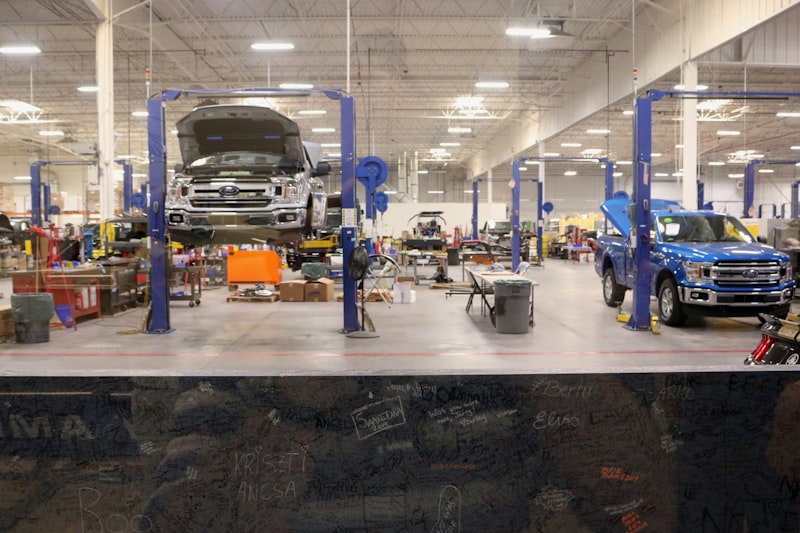Has your car been making unusual noises lately, sounding like a freight train instead of a smooth ride? One possible culprit could be a faulty exhaust manifold. This crucial component plays a pivotal role in expelling gases from the engine, ensuring optimal performance and efficiency. If you’re noticing symptoms like loud exhaust noises, decreased engine power, or even a hissing sound under the hood, it might be time to roll up your sleeves and check that exhaust manifold.
Before diving into repairs, it’s essential to understand what exactly goes wrong with an exhaust manifold. Over time, exposure to high temperatures and stress causes the manifold to crack or develop leaks. These leaks can lead to inefficient exhaust gas expulsion, which not only impacts performance but also poses potential safety hazards due to toxic emissions.
Fixing a faulty exhaust manifold isn’t overly complicated, but it does require a few specific tools and materials. You’ll typically need a wrench set, penetrating oil for rusty bolts, a new manifold gasket, and perhaps a replacement manifold if the damage is severe.
-
Prepare Your Workspace: Start by parking the car on a level surface and ensuring the engine is cool to the touch.
-
Locate the Manifold: The exhaust manifold is usually bolted to the engine block and connects to the exhaust pipe. Locate it under the hood; it resembles a series of pipes leading from the engine.
-
Remove the Old Manifold: Carefully disconnect the bolts securing the manifold to the engine block and exhaust pipe. Use penetrating oil if the bolts are rusty or stuck.
-
Replace Gaskets and Manifold: Once the old manifold is removed, clean the surfaces thoroughly and install a new manifold gasket. Securely bolt the new or refurbished manifold in place.
-
Test and Inspect: After installation, start the engine and listen for any unusual noises. Check for leaks by running your hand along the joints and feel for escaping exhaust gases.
Mastering Mechanics: Step-by-Step Guide to Repairing Your Car’s Exhaust Manifold
Before diving into repairs, diagnose the problem. Start by inspecting the exhaust manifold for visible cracks or signs of leakage. Listen for unusual noises or hissing sounds when the engine is running, indicating potential leaks. Once identified, gather the necessary tools: wrenches, sockets, penetrating oil, and a new exhaust manifold gasket.
Ensure your safety by letting the engine cool down completely before starting work. Exhaust components can be extremely hot, posing burn hazards. Use gloves and eye protection throughout the repair process.

Begin by disconnecting the negative terminal of the car battery to prevent electrical mishaps. Next, remove any heat shields covering the exhaust manifold. Loosen and remove the bolts securing the manifold to the engine block and exhaust pipe using appropriate wrench sizes. Apply penetrating oil to stubborn bolts to ease removal.
Once the manifold is detached, inspect it thoroughly for cracks or other damage. Clean the mounting surfaces on both the manifold and engine block to ensure a secure seal with the new gasket. Use a wire brush to remove any debris or old gasket material.
Carefully position the new exhaust manifold and align it with the mounting studs on the engine block. Install new bolts and tighten them gradually in a crisscross pattern to ensure even pressure distribution. Refer to your vehicle’s torque specifications for precise tightening values.
Reattach any heat shields or brackets removed earlier. Double-check all connections and ensure everything is securely tightened. Reconnect the car battery’s negative terminal and start the engine. Listen for exhaust leaks and monitor engine performance. Rev the engine gently to verify the repairs.
DIY Car Care: Essential Tips for Fixing Your Exhaust Manifold
Firstly, before diving in, ensure your car has cooled down completely. The exhaust manifold can get extremely hot during operation, so safety first! Start by identifying the location of your exhaust manifold under the hood. It’s usually a set of pipes that collect exhaust gases from multiple cylinders and direct them into the exhaust pipe.
Next, inspect the manifold for any visible cracks or leaks. Sometimes, leaks are audible with a noticeable ticking or hissing sound when the engine is running. Once you’ve identified the issue, gather your tools. You’ll typically need a socket wrench set, penetrating oil (to loosen rusty bolts), a gasket scraper, and a new exhaust manifold gasket.
Begin by disconnecting the negative terminal of your car battery to avoid any electrical mishaps. Then, carefully remove the heat shields and any components obstructing access to the manifold. Loosen the bolts securing the manifold to the engine block and exhaust pipes. Be cautious as some bolts can be stubborn due to rust or corrosion.
Once the manifold is free, remove it gently, taking care not to damage surrounding components. Scrape off the old gasket material from both the manifold and engine block using a gasket scraper. Clean the surfaces thoroughly with a rag and some solvent to ensure a proper seal with the new gasket.
Install the new gasket and carefully place the manifold back into position. Tighten the bolts gradually and evenly to ensure a snug fit. Reattach any heat shields or components you removed earlier and reconnect the battery terminal.
Finally, start your car and listen for any unusual noises or exhaust leaks. Take it for a test drive to ensure everything is functioning correctly. By following these DIY tips, you can effectively fix your exhaust manifold and keep your car running smoothly without breaking the bank.
Troubleshooting Car Issues: Repairing the Exhaust Manifold Made Easy
First things first, let’s understand what the exhaust manifold does. Think of it as the lungs of your car, responsible for collecting exhaust gases from the engine cylinders and funneling them into the exhaust pipe. Over time, due to heat and stress, the manifold can develop cracks or leaks, leading to issues like loud noises or decreased engine performance.
Before diving into the repair, it’s essential to diagnose the problem accurately. Are you hearing strange noises when accelerating? Do you notice a burning smell or see smoke coming from under the hood? These could be signs of a damaged exhaust manifold.
To begin the repair process, gather your tools: a socket wrench set, penetrating oil (to loosen rusty bolts), a new manifold gasket, and safety gear like gloves and goggles. Start by disconnecting the battery to ensure safety. Then, locate the exhaust manifold under the hood – it’s typically connected to the engine block.
Next, carefully remove the bolts securing the manifold to the engine. This might require some elbow grease, especially if the bolts are rusted. Once the manifold is free, inspect it for cracks or holes. A flashlight can be handy here to get a clear view.
If you find damage, it’s time to install the new manifold. Clean the surface where the manifold attaches to the engine block, ensuring no debris or old gasket material remains. Place the new manifold gasket in position, then carefully align the new manifold and secure it with the bolts. Tighten them gradually in a criss-cross pattern to ensure an even seal.
After everything is securely in place, reconnect the battery and start the engine to check for any leaks or unusual noises. If everything sounds good and there are no signs of leaks, congratulations – you’ve successfully repaired your exhaust manifold!
Remember, while repairing your exhaust manifold can be a DIY project, if you’re unsure or uncomfortable with the process, it’s always best to seek help from a professional mechanic. With patience and the right approach, you can keep your car running smoothly without breaking the bank.
Expert Advice: How to Detect and Resolve Exhaust Manifold Leaks
Detecting an exhaust manifold leak early can save you from more extensive and costly repairs down the road. One of the most common signs is a ticking or tapping noise coming from the engine bay, especially noticeable during acceleration. This noise is caused by exhaust gases escaping from the manifold before reaching the exhaust pipe.
Another indicator is the smell of exhaust fumes inside the cabin, which suggests that gases are leaking into areas they shouldn’t be. Additionally, a decrease in engine performance or fuel efficiency may occur due to the disrupted exhaust flow.
A visual inspection can also help. Look for black sooty marks around the manifold bolts or seams, indicating where gases might be escaping. If the manifold is accessible, you might even feel small puffs of exhaust gas escaping with the engine running.
Once identified, resolving the issue promptly is crucial. Start by ensuring the engine is cool before beginning any work. Tightening the bolts around the manifold can sometimes solve minor leaks, but often the manifold itself may need to be removed and inspected.
Inspect the manifold for cracks or warping, which are common culprits of leaks. In some cases, a damaged manifold might need to be replaced altogether. When reinstalling or replacing the manifold, use new gaskets and ensure all bolts are properly torqued to manufacturer specifications to prevent future leaks.
Using a quality exhaust sealant can also be effective in sealing minor leaks around the manifold. These sealants are designed to withstand high temperatures and can provide a temporary fix until a more permanent solution is implemented.
Regular maintenance and inspections are key to preventing exhaust manifold leaks. By staying vigilant and addressing any issues promptly, you can keep your vehicle running smoothly and efficiently, avoiding more significant repairs in the future.
Under the Hood: A Comprehensive Approach to Fixing Your Exhaust Manifold
Is your car’s engine sounding louder than usual? It might be time to take a look under the hood, specifically at your exhaust manifold. This crucial component plays a significant role in your vehicle’s performance, responsible for collecting exhaust gases from multiple cylinders and routing them into the exhaust pipe. Over time, wear and tear can lead to leaks or cracks in the manifold, affecting engine efficiency and even causing harmful emissions.
The exhaust manifold is often exposed to extreme temperatures, causing metal fatigue and potential cracks. Symptoms of a faulty manifold include loud ticking or hissing noises during acceleration, decreased fuel efficiency, and even a noticeable decrease in engine power. Ignoring these signs can lead to more extensive engine damage and increased repair costs down the line.
When diagnosing an exhaust manifold issue, a visual inspection can often reveal cracks or leaks. However, sometimes the issue lies deeper, requiring a professional inspection with specialized tools to detect hairline cracks or exhaust leaks that aren’t immediately visible. Depending on the severity of the damage, repair options range from welding cracks to replacing the entire manifold.
Expert mechanics recommend regular maintenance checks to catch manifold issues early. Addressing problems promptly not only ensures your car runs smoothly but also prevents environmental pollution. Moreover, using high-quality replacement parts and following manufacturer guidelines can extend the lifespan of your exhaust system, ensuring long-term reliability.
Taking care of your exhaust manifold is essential for maintaining your vehicle’s performance and reducing emissions. By understanding the signs of trouble and acting promptly, you can save yourself from costly repairs and keep your car running smoothly for miles to come.
Save Money on Repairs: DIY Guide to Repairing Your Car’s Exhaust Manifold
Hey there, fellow car enthusiasts! Ever found yourself staring at a hefty repair bill for your car’s exhaust manifold and thought, “Could I do this myself?” Well, you’re in luck! With a bit of know-how and the right tools, tackling your car’s exhaust manifold repair can save you a bundle. Let’s break it down.

First off, what’s an exhaust manifold? It’s like the lungs of your car, helping the engine breathe by collecting exhaust gases from the cylinders and sending them out through the exhaust pipe. Over time, this part can develop cracks or leaks, causing that dreaded noise and decreasing engine efficiency.
So, why should you consider fixing it yourself? Money, of course! Mechanics can charge a pretty penny for this repair, but with some elbow grease and patience, you can keep those dollars in your pocket.
Before you grab your toolbox, pinpoint the problem. Is it a noticeable noise, decreased engine performance, or a visual crack? Identifying the issue will guide your repair process.
You’ll need basic tools like wrenches, sockets, and possibly a jack and jack stands to safely lift your car. Don’t forget safety gear like gloves and eye protection – safety first, always!
This is where the real work begins. You’ll disconnect the exhaust pipes, unbolt the manifold from the engine block, and carefully remove it. It might be stubborn due to rust, so a penetrating oil can be your best friend here.
Once the old one’s out, it’s time to put in the new. Make sure everything lines up correctly, bolt it back in place, and reconnect the exhaust pipes. Double-check your work to ensure a snug fit.
With the repair done, start your engine and listen for any leaks. Inspect the area for smoke or unusual smells, which could indicate further issues.
By taking matters into your own hands, you not only save money but also gain a deeper understanding of your car’s inner workings. Remember, DIY repairs aren’t just about saving cash – they’re about the satisfaction of a job well done and the confidence to tackle more challenges under the hood.
Ready to revamp your ride? Get those tools ready and roll up your sleeves. Your car – and your wallet – will thank you later.
Preventive Maintenance: Ensuring Your Exhaust Manifold Is in Top Shape
When it comes to keeping your vehicle running smoothly, preventive maintenance is key. One critical component that often gets overlooked is the exhaust manifold. This essential part of your car’s engine plays a crucial role in expelling exhaust gases away from the engine cylinders. To ensure your exhaust manifold remains in top shape, regular maintenance and checks are essential.
Firstly, understanding the function of the exhaust manifold is crucial. It collects exhaust gases from multiple cylinders and directs them into the exhaust pipe. This process helps maintain engine performance and fuel efficiency. Over time, however, the manifold can face issues such as corrosion, cracks, or leaks due to exposure to high temperatures and corrosive gases.
To prevent these issues, regular inspections should be part of your vehicle maintenance routine. Look for signs of rust or corrosion on the manifold surface. Check for any cracks or loose fittings that could lead to exhaust leaks. These inspections can often be done during routine oil changes or inspections by a qualified mechanic.
Furthermore, ensuring proper installation and fitment of the manifold is essential. A loose or improperly installed manifold can lead to exhaust leaks, affecting engine performance and emissions. Tightening bolts to manufacturer specifications and inspecting gaskets for wear are simple yet effective steps in maintaining the manifold.
Additionally, considering the manifold’s exposure to extreme heat, using high-quality materials during replacement or repair is crucial. Stainless steel or cast iron manifolds are known for their durability and resistance to corrosion, ensuring longevity and reliability.
Keeping your exhaust manifold in top shape requires proactive maintenance and regular inspections. By understanding its function and addressing issues early on, you can prevent costly repairs and ensure optimal performance from your vehicle’s engine. Stay proactive, and your exhaust manifold will continue to serve its purpose effectively for miles to come.
Frequently Asked Questions
Can I drive with a cracked exhaust manifold?
Yes, driving with a cracked exhaust manifold is not recommended. It can lead to increased exhaust noise, decreased engine performance, and potentially harmful emissions. It’s advisable to repair or replace the cracked manifold promptly to avoid further damage to your vehicle.
What are the steps to replace an exhaust manifold at home?
Learn the essential steps for replacing an exhaust manifold at home efficiently. Discover the tools needed, the removal process, installation tips, and safety precautions to ensure a successful replacement.
What tools are needed to replace an exhaust manifold?
Learn about the essential tools required for replacing an exhaust manifold efficiently. Discover the specific tools and equipment necessary to complete the task safely and effectively.
How much does it cost to repair an exhaust manifold?
Learn about the cost to repair an exhaust manifold, covering factors like materials, labor, and potential additional expenses. Get insights into typical repair costs and factors influencing them.
How do I know if my car’s exhaust manifold is cracked?
Learn how to identify a cracked exhaust manifold in your car with our concise guide. Discover common symptoms and signs such as loud noises, decreased engine performance, and unusual smells. Ensure prompt inspection and repair to maintain your vehicle’s efficiency and safety.


